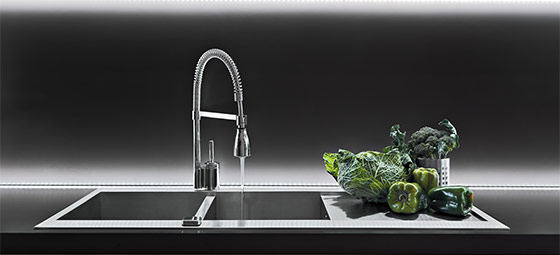Whether you’re replacing your current sink or adding a new sink as part of a kitchen renovation, there are more options than ever before. But all of these options can make it a challenge to figure out which one is the best sink for your kitchen.
The sink is typically the most heavily used fixture in your kitchen and serves as the focal point for the room. The sink you select needs to be able to withstand years of use as well as complement the design of your kitchen. You should also think about how you plan to use your sink.
When shopping for a new sink you should consider the following factors: material, configuration, and mounting.
Material
When it comes to selecting a kitchen sink, price has less to do with performance than material the sink is constructed from. You should look for a material that will stand up to heavy use and complement your décor and fixtures. Popular materials for kitchen sinks include:
Stainless steel is the most popular material for kitchen sinks. It is a durable option that is resistant to heat and stains, making it a perfect choice for heavy use. A brushed or stain finish is preferable over a mirror finish, which will show scratches and water spots more easily. Stainless steel sinks work well with granite or engineered stone countertops. Lower-grade stainless steel is thicker, making for a better quality sink. If you’re concerned about noise with a stainless steel sink, look for one with sound-absorbing pads placed on the bottom and sides of the exterior.
Enamel-coated cast iron sinks are attractive and durable. They are available in a wide variety of colors. They offer a smooth, easy-to-clean surface, but they can show wear over time. Enamel-coated cast iron sinks are made with as much as 80 percent recycled materials and can last for decades.
Solid surface sinks offer a sleek look and can also be integrated into the countertop for a streamlined appearance. With a solid surface sink, there are no ridges to collect dirt and grime, making them easy to keep clean. Because they are solid, scratches can be buffed out easily.
Composite sinks are a low-maintenance option with a lower price point than other materials. They are available in a range of colors, making it easy to find one that complements your kitchen. They don’t show scratches or water marks, but they are less durable than some other materials.
Fireclay sinks are highly resistant to scratches, staining, and chips, as well as bacteria. They are easy to clean and will not rust, fade, or discolor.
Copper sinks are extremely durable and will not rust or tarnish. They also offer antimicrobial properties that kill bacteria and viruses. Copper sinks look great with natural surfaces like wood and stone.
Configuration
You will also need to think about what sink configuration will work best for you. This includes the shape, size, number of bowls, number of holes, and bowl orientation. The size and configuration of your kitchen many influence some of these factors.
Number of bowls – Kitchen sinks are available with one, two, or three bowls. The double-bowl sink is the most popular and is ideal for busy cooks. Choosing a sink with one oversized bowl makes washing bulky pots and pans easier. Single-bowl sinks are good for small kitchens. Triple-bowl sinks work best when you have more than one person cooking in the kitchen at the same time. Triple-bowl sinks typically have two large bowls with one small bowl in the center.
Sink orientation – The best sink orientation will be determined by your workflow as well as the relationship between your sink, dishwasher, and garbage disposal. Having the disposal on same side as the dishwasher is the most efficient. If your sink has one bowl larger than the other, put the disposal in smaller sink on same side as dishwasher.
Size of sink – Consider size of your kitchen when determining what size of sink to select. A large multi-bowl sink will overpower a small kitchen. The National Kitchen and Bath Association recommends a standard 22×24-inch single-bowl sink for kitchens less than 150 sq. ft. Larger kitchens can accommodate larger double and triple bowl models. If you are only replacing your sink, but not your countertop, you may be locked into picking a sink the same size as your existing sink.
Sink depth – Kitchen sinks usually range in depth from 6 to 12 inches. Deeper sinks will reduce splash but can be uncomfortable to reach to the bottom, depending on your height. Also keep in mind that undermount sinks will end up about 1 ½ inches lower than a drop-in. If you are using a double-bowl sink, consider selecting one with one deeper bowl and one that is shallow.
Number of holes – The number of holes in kitchen sinks range from one to five to accommodate the faucet, as well as accessories such as spray hoses and soap dispensers. Your sink needs to match the number and spacing of hole with those needed by your faucet configuration. You can place a base plate over any unused holes, but don’t try to drill additional holes into a sink.
Mounting
Most kitchen sinks fall into one of two mounting styles: drop-in or undermount.
Drop-in sinks are dropped into a pre-cut hole in the countertop and are either rimmed with a steel rim or are self-rimming. They may be secured to the counter with clips or screws.
Undermount sinks are installed beneath the counter, eliminating the need for a rim between the countertop and the sink. The lack of a rim makes undermount sinks easier to clean food from your counter. You can simply wipe it directly into the sink. Undermount sinks are not recommended for laminate countertops.
While you’re installing a new kitchen sink, consider also installing a new faucet at the same time. It is much easier to install a faucet before the sink is put into place than to install it later.

